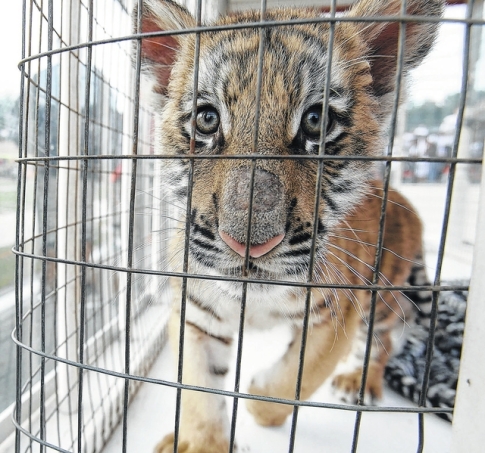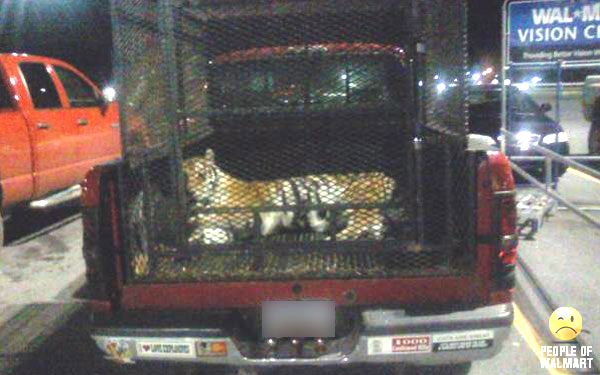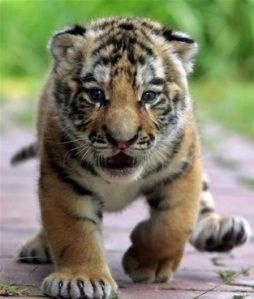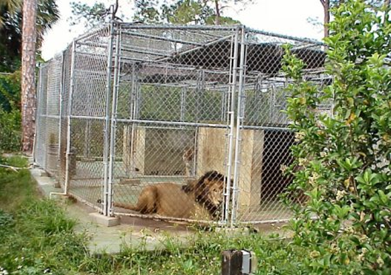Tiger cub ”Obie” – 2015 mascot for the Massillon High School football team.
The Big Cat and Public Safety Protection Act is simply the most important piece of legislation to ever be introduced to protect lions, tigers and other exotic wild cats. This bill will be introduced in the 2015 legislative session of the United States Congress; and in 2014, had the bipartisan support of 119 lawmakers. We are optimistic that this bill will obtain enough support to finally be passed into law this year; and is supported by all the major animal welfare organizations, including the Humane Society of the United States (HSUS), The International Fund for Animal Welfare (IFAW), Born Free USA, Big Cat Rescue, and others.
SO WHAT EXACTLY IS THE BIG CAT PUBLIC SAFETY PROTECTION ACT ?
• It would end the private possession and breeding of lions, tigers, leopards, snow leopards, clouded leopards, cheetahs, jaguars, and cougars, as well as any hybrid of these species.
• It would include a grandfather provision for current big cat owners to continue keeping these animals as long as they are registered with the U.S. Department of Agriculture, but they could not breed and the exemption would only apply to big cats they currently own.
• Exemptions would be granted to all Zoos accredited by the Association of Zoos and Aquariums (AZA), certified related facilities that coordinate with the AZA Species Survival Plan for breeding of species listed as threatened or endangered, wildlife sanctuaries that do not breed or allow public handling of animals, wildlife rehabilitators, state colleges and universities, and select traveling circuses in compliance with the Animal Welfare Act.
WHY DO WE NEED THIS LEGISLATION?
First and foremost, it protects humans and it protects animals. It is estimated that there are somewhere between 10,000 and 20,000 big cats currently held in private ownership; but of course, the exact number is a mystery. But in the past 21 years, there have been 22 reported deaths, 248 maulings, 260 escapes, 144 big cat deaths and 131 confiscations as a direct result of the private ownership of the big cats. These big cats include tigers, lions, cougars, leopards, jaguars, cheetahs and others.
Secondly, it is necessary to protect the welfare of the animals. Big cat owners generally fall into two categories. Private owners often take in a pet lion or tiger cub, believing they would make a wonderful pet. Unfortunately, there are not a lot of 400 lb., 500 lb., or 700 lb. animals that make good pets and once fully grown, the private owner then realizes he or she is incapable of managing or taking care of the big cat. Consequently, the animals are frequently abused and often spend their entire lives in cages with barely enough room to move.
And in many cases, that realization is made long before the cat even becomes fully grown. Take for example the 3-month old Bengal-Siberian Tiger cub recently found wandering the streets of Los Angeles. He had been declawed and had a hernia in his abdomen.
The other private owners are those for-profit operations that disguise themselves as conservationists and would have you believe that they have the big cats’ best interests at heart. They do not. They intensively breed big cats to feed the trade. They prematurely take the cubs away from their mothers, subject them to the constant handling of hundreds of paying customers that are willing to pay good money to hold and be photographed with a cub. The cubs are often drugged and sedated so that they will be calm and behave during this interaction. Once the cubs are too big, they are sold to roadside zoos, sold as backyard pets, sold on the black market for their hides and bones, or just killed outright.
The deplorable living conditions of the big cats are the rule and not the exception. Even the regulations promulgated by the USDA under the Animal Welfare Act (AWA) set minimum standards that allow these cats to spend their entire lives in small, concrete and chain link cages that are in effect prison cells.
And even when these minimum standards are not met, the USDA only has about 100 inspectors nationwide to police over 2,700 exotic animal exhibitors and thousands of other animal facilities. These facilities are often cited but only the worst of the worst are ever shut down. As a result, the vast majority of big cats live in conditions that any compassionate person would view as cruel and inhumane.
DON’T BE FOOLED BY THE CRITICS
Do not be fooled by groups such as the Zoological Wildlife Foundation, a group that touts itself as a conservation group, but provides wild animals for events and gives educational tours at its facility in Miami. They attempt to argue that the bill would prove disastrous for conservation efforts because it would limit the breeding and sales of the big cats.
The Zoological Wildlife Foundation argues that those facilities that keep, rent out and host events featuring wild animals can be big business; with those dollars going to conservation efforts and charities worldwide. Well, of course. Anyone with a profitable business could contribute these dollars to conservation efforts or to any charities they chose. Trophy hunters could just donate $50,000 to a charity or conservation cause of their choice, rather than spend it on a license necessary to kill a trophy lion. I could donate my discretionary income to a charity or I could use this to buy myself a brand new car. A poacher could decide to stop poaching. The point is just because they could invest these dollars on conservation causes certainly does not mean they will. And after all, the road to hell is paved with good intentions.
And they further argue against this legislation because simply, it would put them and many others that depend upon the exploitation of the big cats out of business. And the exploitation and exhibiting of big cats does absolutely nothing for conservation. Undercover operations by the U.S. Fish & Wildlife Service over the past decade have demonstrated that there is an illegal trade in big cat parts, including skin and bones. The more these parts are supplied from the captive big cat population, the more the market for these parts grows, and the more demand grows for the real or premium product (i.e. parts from big cats poached from the wild).
And of the estimated 5,000 captive tigers in the United States, only about 250 of these are considered pure bred subspecies and these are all housed in AZA accredited zoos. The remainder is considered generic (i.e. cross bred between two or more subspecies). So, they have no conservation benefits whatsoever.
In my research, I read an email published through opencongress.org and was compelled to include certain sections of this letter for response. I do this because there are probably other critics of this legislation that have similar opinions which quite frankly, are based upon misguided beliefs and incorrect analyses. Understanding the intent of this legislation is important. Therefore, I have provided this email below, with an applicable response to each section.
Email Comment “A small group of feline sanctuary owners think they are the only people who should be allowed to possess wildlife, and PETA, HSUS and Born Free are promoting this act because it furthers their main goal of forcing captive populations into extinction. These animal rights extremists truly believe two things – “ better dead than bred”, and “they belong in the wild”. The Big Cats and Public Protection Safety Act combine both these crazy goals, making big cat species unavailable for photography, movies, circus, television, movies, stage shows, private possession, outreach education, nature centers, or independent zoos.”
Response: First of all, I do not like and have never cared for the word “extremist”…particularly when it is used to make a blanket generalization across a wide swath of people. Dictionary.com defines an extremist as someone who supports or advocates extreme doctrines or practices, and the British version of Dictionary.com defines an extremist as a person who favors or resorts to immoderate, uncompromising, or fanatical methods or behavior.
In all walks of life, there will always be those people who meet this definition of extremist. However, to suggest that legislation designed to protect exotic cats from living in deplorable, abusive, and horrendous living conditions, to protect the general public that is at risk if these animals were to escape, and to take steps to crack down on the black market of illegal trade of these exotic animals is not exactly what I would view as that promoted by extremists.
Further, I would speculate that the majority of Americans, if they read this legislation, would be in favor of this. And if this is the act of extremists, then count the 119 congressional representatives that supported this bill last year as part of that group!
And ask this “small group of feline sanctuary owners” to state their ultimate goal and they will unequivocally emphasize their desire to go out of business. These sanctuaries only exist as a safety net for the big cats that are deserted by their former owners because surprise, surprise – big cats do not make good pets. They are the safety net for those roadside zoos that are mercifully shut down after years of abusing, neglecting and mistreating these beautiful animals. They are the safety net for those animals that are no longer considered cute enough to be displayed in public. So, the idea that they believe “better dead than bred” is incorrect. Without these dedicated organizations, all of these exotic animals would have been euthanized or killed long ago.
And these animals do belong in the wild. Yes, of course. Why would anyone think otherwise about lions, tigers, cheetahs, leopards, elephants, wolves, polar bears, rhinos, hippos, etc.? They definitely belong in the wild.
Finally, why do these animals need to be made available for photography, movies, circuses, television, stage shows and private possession? Many of these groups are the cause and the exact reason this legislation has been introduced in the first place. All wild and exotic animals can be filmed freely in their natural habitats in the wild. They can be seen via National Geographic and other nature specials. Type African Lion into YouTube and you get 326,000 videos. At an average of 5 minutes per video, that is enough to watch 3 years of non-stop videos just on African lions, without eating, sleeping or anything else. And in reality, we don’t need lions or tigers in movies…there are plenty of movies with story lines that have nothing to do with the big cats, and when was the last time you watched a movie that involved a lion or a tiger? And the Lion King doesn’t count because that was animated.
Circuses and stage shows? Feld Entertainment, owner of Ringling Brothers Circus announced that they would finally end the use of elephants in their traveling circus by 2018. Alana Feld, the company’s executive vice president stated “clearly there’s been somewhat of a mood shift among our consumers. We’re not reacting to our critics; we’re creating the greatest resource for the preservation of the Asian elephant.”
Whether that decision was truly based upon some type of moral or ethical epiphany, or was influenced by those critical of the use of elephants in their acts really is not important. What is important is that they did this for the elephants. And if they can do this for the elephants, then they can do it for the big cats.
And if countries like Austria, Belgium, Bosnia, Herzegovina, Bulgaria, Croatia, the Czech Republic, Cyprus, Denmark, Estonia, Finland, Greece, Hungary, Ireland, Malta, the Netherlands, Norway, Poland, Portugal , Slovenia, Spain, Sweden, the UK, much of Canada, Argentina, Bolivia, Brazil, Chile, Columbia, Costa Rica, Ecuador, El Salvador, Mexico, Panama, Paraguay, Peru, Australia , India, Israel, Singapore, and Taiwan can make the humane and right decision to ban most if not all exotic animals in circus acts, is it that difficult for the United States to step up and do the same? We are not stepping out on the limb and taking the lead on this. According to http://www.stopcircussuffering.com, there are 41 other countries that have already done this. We can do this, too.
The only groups referenced in this email deserving further conversation and debates are the outreach education centers, nature centers and independent zoos. The simple answer is that any organization desiring to own exotic animals must be AZA accredited. I am not going to profess my expertise on what one must do to qualify for this accreditation. However, nothing would prevent the AZA to coordinate efforts with these groups and those that truly meet standards in place to protect these animals would receive such accreditation.
Email Comment: Federally licensed cat breeding facilities that would be affected by this act are mainly zoos and wildlife educators. Private breeders of wild felines also breed species not held by AZA members, such as Bengal and mixed tigers, Asian and African leopards. This act would drive these felines into extinction in America.
Response: Correct, but these are not North American species in the first place. Leopards are primarily found in their native Africa; Tigers in India and Pakistan, and Lions from Africa and Asia. Additionally, the private breeders of the exotic animals are the biggest part of the problem. The recipients of these breeding programs are private owners who have already proven an inability to be responsible owners; roadside zoos that subject these animals to horrendous living conditions; captive farms that expose these animals to the cruel and controversial practice of canned trophy hunting, and sold on the black market for their pelts and bones. The point is that with exception of zoos, and even that is a debatable topic in the 21st century, these exotic animals never belonged in the United States.
Zoos are a topic for another day, but I do agree that zoological parks can provide great educational opportunities. However, the history of the modern zoo dates back to 1793 with the opening of the Paris Zoo. So, for nearly 200 years, the zoo was essentially the only place one could visit to see live animals. With the advent of television which provides access to nature programs; the internet which provides an unlimited access to information on any animal (type in African Lion and you get 14.5 million hits); and YouTube, which provides us unlimited access to video footage of any animal you could possibly think about, some could argue that the zoo has essentially become unnecessary.
Life evolves. We evolve. The horse and buggy used to be the primary mode of transportation in the United States. I would surmise that outside of Amish country, not a lot of people rely on the horse and buggy for transportation anymore.
Email Comment: Non-AZA member zoos and breeding centers provide valuable wildlife viewing opportunities in communities all across America, especially in the more rural areas that do not meet the high traffic requirements of the AZA. This bill would prevent these zoos from breeding or obtaining new big cats to exhibit to the public.
Response: Breeding centers, whatever these are, sound similar to private breeders and that has already been addressed. As far as the accreditation requirements, there are currently 218 zoos and aquariums nationally that have taken the necessary steps to meet the AZA requirements.
And according to the AZA, the Accreditation Commission evaluates every zoo or aquarium to ensure it meets the AZA’s standards from “animal management and care, including living environments, social groupings, health, and nutrition.” They also evaluate “the veterinary program, involvement in conservation and research, education programs, safety policies and procedures, security, physical facilities, guest services, and the quality of the institution’s staff.” And they also evaluate “each institution’s finances, its governing authority and its support organization.”
The reality is probably true that some of the rural zoos may not generate enough foot traffic to meet the AZA’s financial standards. However, if the facility cannot meet the financial demands, then it is almost certain that the veterinary program, conservation and research, education programs, safety policies, security physical facilities, guest services and staff quality are also going to suffer as well …which of course, will also impact the quality of life of the animals.
So will this impact some of these zoos? Unfortunately yes. However, these zoos have the responsibility of ensuring the highest quality standards of life for these animals, and we should also demand this.
Email Comment: The Big Cats and Public Protection Safety Act is a deceptively named piece of legislation that seeks to force the extinction of American-held wild feline species. By implying that American held big cats are being involved in the global black market, without any evidence to back up this statement, and using the phrase “public safety” in the Act’s title and supporting language, this animal rights agenda is dishonestly packaged.
Response: There is nothing deceptive about the name. If you wish to focus on the public safety aspect of this legislation: 22 deaths, 248 maulings, 260 escapes, 131 seizures. But of course, it is true that the act must include Public Safety in the title because there are many out there that do not have the compassion for animals. If this bill was entitled the “Protect Big Cats Act”, it would not create the same level of support. That is unfortunate, because of course, the animals do deserve this type of protection. But call it what you will. The act protects both humans and the big cats. Is that a bad thing?
Finally, to address the issue as to “no evidence to back up the fact that Americans are being involved in the global black market of selling these exotic cats”. First of all, the black market is a shadow market that trades in illegal traffic or in officially controlled or scarce commodities. Economic activity is not recorded and taxes are not paid. If the black market was transparent in its activities, what was bought and sold, it wouldn’t be a black market.
However, according to the Animal Legal Defense Fund, the illegal trafficking of rare and exotic wildlife is estimated to be a $10 to $20 billion dollar industry; and according to United For Wildlife, the illegal wildlife trade is the fourth most lucrative trade industry, only surpassed by drugs, human trafficking and the arms trade.
With a trade that substantial, poaching alone could never support this type of demand. Is the United States the only country with citizens involved in this black market activity? Of course not. However, with an estimated 10,000 to 20,000 exotic big cats in private ownership in the U.S., and a $10 to $20 billion illegal trade industry, I don’t believe it is a stretch to assume that there is a measurable connection between the two.
This legislation is simply the most important piece of legislation to ever be introduced to protect lions, tigers and other exotic wild cats.
SO WHAT CAN I DO?
First, download the Big Cat Public Safety Act fact sheet and share with your friends and lawmakers. http://www.ifaw.org/sites/default/files/BigCatsPublicSafety_0.pdf
Secondly, listen to a radio interview with Howard Baskin , CFO of Big Cat Rescue; or research this issue so you can better understand the plight of these big cats. Not only those in captivity, but of the lions that roam the African and Asian plains. Learn more about Cecil. Learn more about the canned hunting of wild animals. Learn of the plight of the tiger and the leopard. Learn about the crisis faced by the elephants and rhinos. Knowledge is power and the more you know, the better you can communicate the issues and make positive change.
Third, find your United State Senators and Representatives with this link, including name, phone number, mailing address and email address: https://www.opencongress.org/people/zipcodelookup. Then click on this link and email your congressional representatives:
http://salsa4.salsalabs.com/o/51389/p/dia/action3/common/public/?action_KEY=13966
Fourth, keep your eyes and ears open. If you see what appears to be a potential abusive situation, report it. Facebook and social media have proven that pressure from the masses can successfully force action. Governmental agencies simply do not have the manpower to oversee and monitor on their own. They depend upon citizens to speak up and report cases of animal abuse…including exotic animals as well as domestic pets.
Remember, we must speak for those who can’t. As stewards of our environment, it is our responsibility to protect these magnificent creatures. Passage of the Big Cat Public Safety Act in 2015 will represent a significant victory for both the big cats and for the general public.








Great Job Good Luck Count on me
LikeLike
Thank you Sergio. Everything you and everyone does matters and makes a difference. Don’t ever believe that because you are just one person, you can’t make a difference. Because you definitely can.
LikeLike
Thank you guys for all your hard work and dedication to helping these animals. I know I have become much more informed about their issues though your articles. I really hope some politicians get on board with this because it will certainly influence my vote.
LikeLike
Thank you very much, and that is exactly the idea. There is so much activity swirling around from a domestic and international perspective; and it is difficult to wrap your arms around the various legislative efforts. So, the goal is to simplify and communicate a clear and concise message. As I noted in my first article – “Cecil The Lion – An Agent of Change”, “What does bring change is a cohesive, unified front toward a united cause; a consistent story supported by facts, and the patience and persistence to see it through.”
LikeLike
These animals belong in the wild FREE and NOT used for Human entertainment! And especially NOT for TROPHIES!
LikeLike
Yes Amy. We can do better than this!! We should be evolving toward a higher plane of consciousness. Unfortunately, some people are not to that same level of advancement as the rest of us.
LikeLike
This is an incredible article. It sounds very much like the presentation I made several weeks ago in my Public Speaking class. I addressed many of the topics you covered, handed out the fact sheet you mentioned and gave each of my class mates the email/phone numbers for CA congress members and local representatives. I provided my list of sourced web sites and I urged my class to get involved in some way. What I find truly disturbing is how few people realize and understand the value of our apex predators; how linked we are to them and to our planet. No one thing stands alone; we are each and every one of us connected to our big cats, elephants, rhinos, orangutans and our environments, their environments! I’m raising my voice as often as possible, I’m listening to my planet and I’m thankful to people like yourself who take the time to put the words together and for standing up for what’s right. I’d be happy to work for the USDA as an enforcer, however it appears they aren’t hiring…?
LikeLike
Hi Tara. That is wonderful that you actually had an opportunity to present this subject before your class, and that you had even passed out emails and phone numbers for your Congress members and local representatives. You are doing exactly what we all need to be doing. Thank you for that and thank you for the compliment on my article.
LikeLike
Reblogged this on Big Cat Rescue.
LikeLike